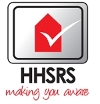Housing Health and Safety Rating System (HHSRS) and Enforcement

The Housing Act 2004 made major changes to the way councils enforce housing standards in their areas, through the introduction of the Housing Health and Safety Rating System (HHSRS).
The HHSRS is designed to keep the occupants of buildings safe and well by removing any potential hazards in the property. If you reside or own a property in South Holland and are concerned about your housing conditions or would like further information you can contact the Housing Standards Team by calling 01775 761161
If a property you're concerned about is not in South Holland, you'll need to contact the Local Authority where it is located (where Council Tax is paid).
Useful HHSRS links and documents
- GOV.UK HHSRS guidance for landlords and property related professionals (opens new window)
- GOV.UK HHSRS guidance (opens new window)
Health and safety hazards
The HHSRS covers 29 potential health and safety hazards:
| Health and safety hazards | ||
|---|---|---|
| Asbestos | Excess cold | Lead |
| Biocides | Excess heat | Lighting |
| Carbon monoxide | Explosions | Noise |
| Collision and entrapment | Falling between levels | Personal hygiene |
| Crowding and space | Falling on stairs etc | Radiation |
| Damp and mould | Falls associated with baths | Structural collapse |
| Domestic hygiene | Falls on a level | Uncombusted fuel gas |
| Electrical hazards | Fire | Volatile compounds |
| Entry by intruders | Food safety | Water supply |
| Ergonomics | Hot surfaces | |
HHSRS inspections
Formal inspections are carried out by suitably trained and competent inspectors and in accordance with the risk-based HHSRS model. The model is used to identify potential risks and hazards to health and safety arising from any deficiencies identified in the dwelling.
Following an inspection, each hazard is assessed separately and if judged to be serious it'll be deemed as a category 1 hazard. All other hazards are known as category 2 hazards.
Hazard enforcement action
If we discover category 1 hazards in a home, we have a duty to take the most appropriate action. We also have discretionary powers to act in the case of category 2 hazards. We can take enforcement action in several ways:
- Improvement notices - these require you to start making repairs within 28 days.
- Prohibition orders - these prevent you or your tenants using part or all of a building.
- Hazard awareness notices - these identify a problem and give you advice about how to fix it.
- Emergency remedial action notices - we can take action to fix category 1 faults posing an imminent risk of serious harm to tenants, like the possible collapse of part of a building.
- Emergency Prohibition order - where there is an imminent risk of serious harm and it is not practical to take remedial action immediately.
- Demolition orders - a possible emergency response to a category 1 fault.
We must consider what action is appropriate in the circumstances and separate enforcement notices have to be served for each hazard. We can also charge for certain enforcement actions.
A property owner who feels that an assessment is wrong can discuss matters with the inspector and ultimately will be able to challenge an enforcement decision through the Residential Property Tribunal.
Failure to comply with a statutory notice could lead to a fine and/or the council carrying out work in default.
